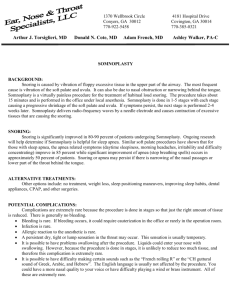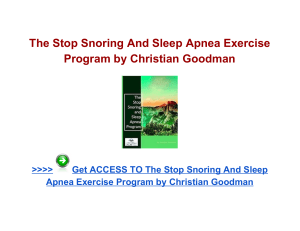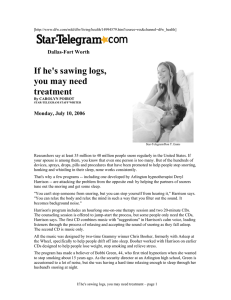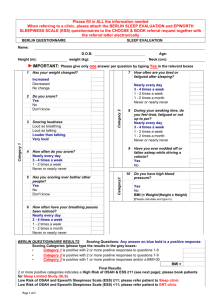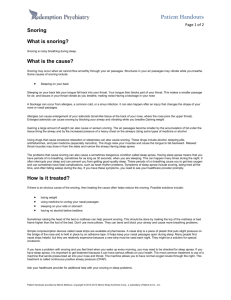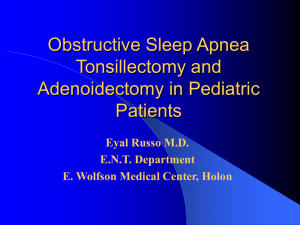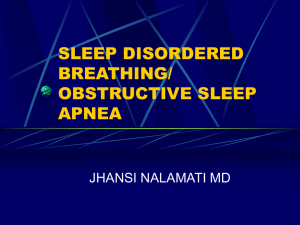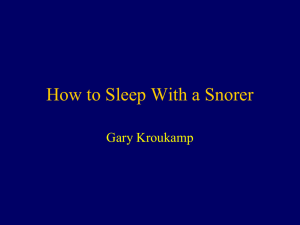Snoring - Great Western Hospital
advertisement
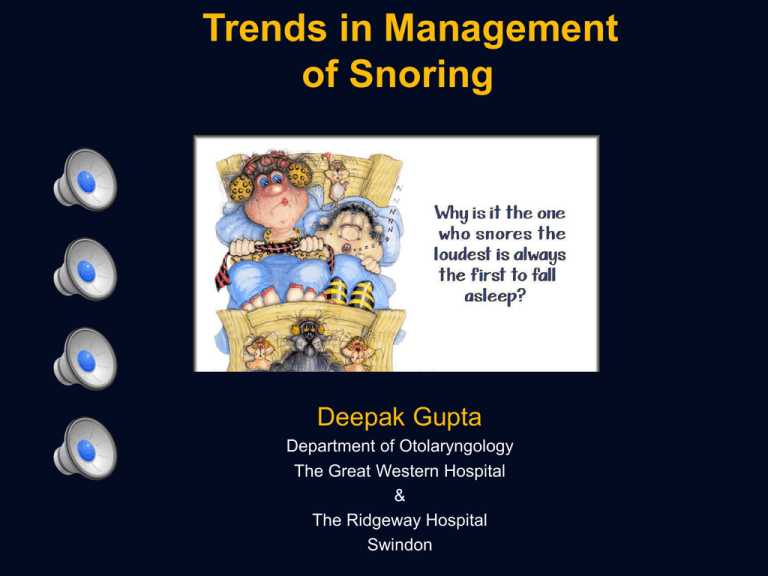
Trends in Management of Snoring Deepak Gupta Department of Otolaryngology The Great Western Hospital & The Ridgeway Hospital Swindon Snoring • • • Definition: Rough, noisy breathing during sleep, due to vibration of uvula and soft palate, maybe tongue Mechanism: Obstructive air flow leading to turbulence which vibrates soft tissue in the mouth and throat to produce sound. Incidence: Men 24% - 50%, women 14% -30% Sleep-Disordered Breathing (SDB) Simple Snoring Upper Airway Resistance Syndrome (UARS) Mild Obstructive Sleep Apnea Syndrome (OSAS) Severe Obstructive Sleep Apnea Syndrome (OSAS) Collapsible Portions of Upper Airway Consequence of Snoring • Social – the sound of Snoring may lead to marital disharmony or social embarrassment • Sleep disturbance and fragmentation lead to excessive daytime sleepiness e.g. traffic accidents • Sore throat Quantifying Snoring • Frequency • Position sensitivity • Witnessed apnoeic episodes • Duration • Degree of disruption Clinical Assessment • Obesity – Neck Circumference • Alcohol • Smoking • Daytime Sleepiness • Witnessed Apnoeas • Abnormal nocturnal motor activity • Other nocturnal events • Epworth Clinical Examination • Body Mass Index (BMI)/Neck • Nasal Obstruction • Oral cavity/Oropharynx • Laryngoscopy Signs/Symptoms of Sleep Apnea • Breathing sounds during sleep • Excessive daytime sleepiness • Fatigue • Changes in alertness, memory, personality • Hypertension/CHF • Impotence • Headaches • Bedwetting Assessment of Sleep Apnea • Epworth Sleepiness Scale • Nocturnal oxygen saturation • Home sleep testing -Apneagram • Polysomnography • • • • • • • • • Epworth Sleepiness Scale 0-24 Sitting and reading Watching TV Sitting inactive in a public place As a passenger in a car for an hour Resting in the afternoon Sitting and talking to someone Sitting after lunch without alcohol In a car while stopping for a few minutes in traffic Chance of dozing 0=never 1=Slight 2=moderate 3=High • • • • How to assess the region of obstructions • To determine a surgical procedure it is valuable to know the location of the nocturnal obstruction. Deciding on a Treatment Option General Treatment for SDB • Control of body weight • Behavioral modification • avoid full dinner and excess alcohol • sleep in lateral or prone position Patient Administered Treatments Worth a Fortune! Oral Appliances • Mandibular repositioning devices(MRD) • Tongue retaining devices MRD •Good compliance •Reduce frequency, intensity and duration of snoring •Xerostomia •TMJ pain •Dental pain •Myofacial pain •Bite change Nasal CPAP •Very effective •Low compliance when used for snoring alone •70% prefer less effective MRD •http://www.dailymail.co.uk/ health/article-81411/Tensnoring-cures.html Surgical Interventions • • • • • • • Nasal Surgery – poor prediction of success Adenoid/Tonsil Surgery Palatal Surgery 50-95% short term success 45-75% long term success Poor correlation between objective decrease in intensity and subjective improvement Maintenance of fall in snoring volume Tongue base surgery Jaw advancement Hyoid myotomy and suspension Tracheostomy • • • • Why should we operate • May be the only tolerable option • Only ‘permanent’ option • Good results • Mimimal complications Why not to operate • Variable success • Insufficient evidence base • May make future CPAP use difficult • Recurrence with time and age Intra Palatal Surgery •Diathermy •Cold steel •Radiofrequency •Laser •Injection Sclerosis •Intra palatal devices •Low morbidity •LA •Out-Patient Procedure •Repeatable •UPPP still possible •SR 30-80% in short term •Possible decrease in long term Best for BMI less than 25,Tonsil grade 1 & 2, AHI less than 25 • Radiofrequency Ablation RFA • • • • Snoring, mild/moderate OSAS Interstitial volume reduction and stiffening Local anaesthesia/out patient Day procedure Anti-snoring device (ASD implants) • Pi Medical (Minnesota, USA) • Year 2000 • Increase stiffness of soft palate • Permanent implant Uvulopalatopharyngoplasty * * * Laugh and the world laughs with you snore, and you snore alone Mark Twain Thank You – and sleep well
